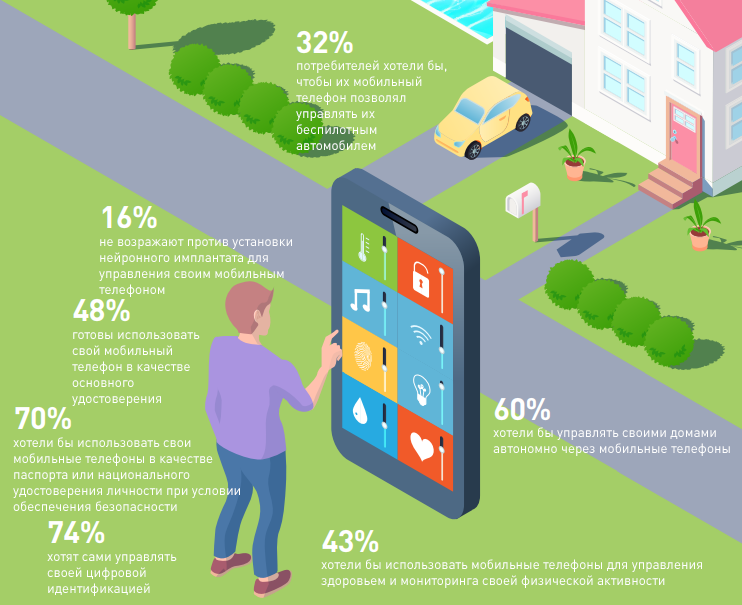How to meet consumer expectations regarding the Internet of Things? (survey results)
Connected devices, including smartphones and wearable electronics, are, without a doubt, an important and often predominant part of home appliances in our lives. However, solutions and technologies available today often work separately and separately, and sometimes it takes a lot of effort to get them synchronized with each other. Therefore, it is important that the main players in this industry work in close cooperation with each other, achieve the compatibility of their devices, providing the most complete and unified user experience.
In order to better navigate this issue and look into the future, we have ordered several large-scale studies that will help us evaluate exactly how consumers imagine the ideal user experience in today's connected world.

Since 2016, we have surveyed more than 5,000 consumers from nine countries and got to know their opinions, ideas, impressions and experiences. The results obtained allowed us to better understand the current (and future) desires of consumers - we learned what their expectations from the ecosystem of connected objects were, and also found out what points the device manufacturers, retailers and OTT service providers should pay attention to.
')
In the course of the consumer survey, three main directions emerged, raising most questions:
In order to better illustrate the findings and to reflect the “aspirations of the people” as fully as possible, we decided to use the help of two fictional characters.
Meet Paul and Emma.

Emma and Paul are closely following the development of technology - they are well aware of the solutions and products available on the market today, and have high hopes for the future. Below we give a few examples and excerpts that will allow you to get a better idea of the expectations of Emma and Paul.
We start with a representative analysis of the data and first turn to Emma. It represents the multitude of consumers who want a unified user experience that allows them to manage the most diverse aspects of their lives with maximum convenience - through their smartphone. Therefore, we must remember that the smartphone has become the center of our connected life, it is important to ensure the harmonious interaction of all the main parties involved in the creation of this consumer experience. Without close cooperation, this will not be possible. However, in this case, the burden of responsibility lies mainly on mobile phone manufacturers, since almost half of the respondents (46%) believe that it is the OEMs who are most able to influence our future experience with mobile technologies (2025).

But the aspirations of users are by no means limited to the ability to control their lives through a smartphone. For example, Paul would like to use his phone as an identity card. A similar usage scenario has already been implemented in Colorado (USA), where the Digital Drivers Licenses system is deployed in pilot mode. We emphasize once again that for the implementation of such initiatives, closer interaction between various industry participants is needed.

Another key discovery in our research is the importance that consumers place on data privacy issues, and in particular data segregation. Users want to control who will have access to this or that data, and they want to control access easily and safely, without any fuss. Such expectations are quite feasible, especially considering that Emma would like to connect all her devices through a single contract.

Consumers also expect the most complete use of biometric technology. In particular, they believe that biometric authentication methods, for example, using fingerprint scanning or face recognition, will be widespread in the future and will become an essential attribute when working with a mobile phone. In addition, consumers expect security in mobile technologies will also be transparent to the user (60%). Moreover, arguing about the future mechanisms of unlocking their smartphones, users are introducing new forms of biometric authentication. In particular, 40% of respondents expect the appearance of voice biometrics, approximately the same number of users (43%) believe that the iris scan will receive a mass character. As you see, “complexity” and “organicity” are key requirements of consumers, and all this is achievable only if there is close interaction between all the main parties involved in the development of such technologies.
Of course, we have given here just a few examples. More information about the expectations of consumers can be in our report (English).
In order to better navigate this issue and look into the future, we have ordered several large-scale studies that will help us evaluate exactly how consumers imagine the ideal user experience in today's connected world.

Since 2016, we have surveyed more than 5,000 consumers from nine countries and got to know their opinions, ideas, impressions and experiences. The results obtained allowed us to better understand the current (and future) desires of consumers - we learned what their expectations from the ecosystem of connected objects were, and also found out what points the device manufacturers, retailers and OTT service providers should pay attention to.
')
In the course of the consumer survey, three main directions emerged, raising most questions:
- Problem of trust in connected objects
- The urgent need for a unified consumer experience
- Personalization of services
In order to better illustrate the findings and to reflect the “aspirations of the people” as fully as possible, we decided to use the help of two fictional characters.
Meet Paul and Emma.

Emma and Paul are closely following the development of technology - they are well aware of the solutions and products available on the market today, and have high hopes for the future. Below we give a few examples and excerpts that will allow you to get a better idea of the expectations of Emma and Paul.
We start with a representative analysis of the data and first turn to Emma. It represents the multitude of consumers who want a unified user experience that allows them to manage the most diverse aspects of their lives with maximum convenience - through their smartphone. Therefore, we must remember that the smartphone has become the center of our connected life, it is important to ensure the harmonious interaction of all the main parties involved in the creation of this consumer experience. Without close cooperation, this will not be possible. However, in this case, the burden of responsibility lies mainly on mobile phone manufacturers, since almost half of the respondents (46%) believe that it is the OEMs who are most able to influence our future experience with mobile technologies (2025).

But the aspirations of users are by no means limited to the ability to control their lives through a smartphone. For example, Paul would like to use his phone as an identity card. A similar usage scenario has already been implemented in Colorado (USA), where the Digital Drivers Licenses system is deployed in pilot mode. We emphasize once again that for the implementation of such initiatives, closer interaction between various industry participants is needed.

Another key discovery in our research is the importance that consumers place on data privacy issues, and in particular data segregation. Users want to control who will have access to this or that data, and they want to control access easily and safely, without any fuss. Such expectations are quite feasible, especially considering that Emma would like to connect all her devices through a single contract.

Consumers also expect the most complete use of biometric technology. In particular, they believe that biometric authentication methods, for example, using fingerprint scanning or face recognition, will be widespread in the future and will become an essential attribute when working with a mobile phone. In addition, consumers expect security in mobile technologies will also be transparent to the user (60%). Moreover, arguing about the future mechanisms of unlocking their smartphones, users are introducing new forms of biometric authentication. In particular, 40% of respondents expect the appearance of voice biometrics, approximately the same number of users (43%) believe that the iris scan will receive a mass character. As you see, “complexity” and “organicity” are key requirements of consumers, and all this is achievable only if there is close interaction between all the main parties involved in the development of such technologies.
Of course, we have given here just a few examples. More information about the expectations of consumers can be in our report (English).
Source: https://habr.com/ru/post/337498/
All Articles